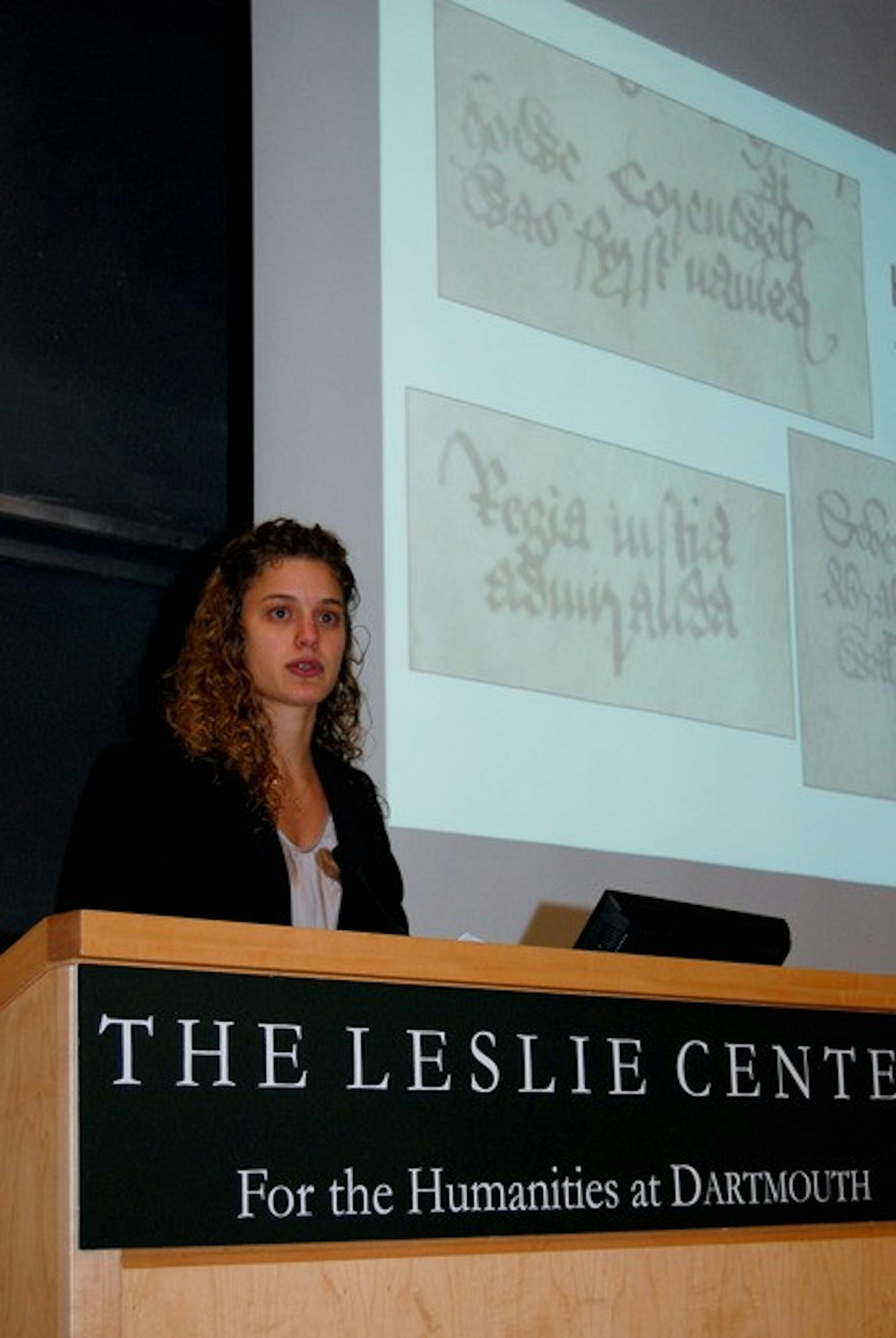The event explored topics ranging from the development of book-making to the significance of the manuscript's marginal annotations all centered around the narrative of Dartmouth's Brut Chronicle, a 121-leaf manuscript written in Middle English prose.
The story traces the arrival of the Anglo-Saxons in the 9th century and the Norman conquests of the 11th century, and also includes many well-known tales, such as those of King Lear, King Arthur and Henry V., according to comparative literature professor Michelle Warren, who organized the conference. The Brut Chronicle constantly evolves over time and currently includes 180 different accounts translated into French and Welsh, which were also spoken in England at the time.
"They're added to, revised and changed, and there are hundreds of manuscripts with no two telling the exact same version," Warren said.
The Dartmouth Brut combines versions of the narrative that were previously separate in other manuscripts, and there is no other manuscript that has the exactly the same combination of texts, according to Warren.
The Brut Chronicle was acquired through the William L. Bryant Foundation Library fund in 2006 in an effort to expand Rauner Special Collections Library's selection of secular materials from the Middle Ages, according to Warren.
Approximately 20 classes in literature, history and technology use the manuscript each year, she said.
Dartmouth's Brut contains a high number of annotations made by as many as 10 individuals and dating as far back as the 17th century, according to Warren.
"Annotations tell us about the way people were reading the text, and show that they kept reading and writing in it," Warren said.
The few scholars in the country who publish regularly on the Brut tradition were present at the conference, according to Emily Ulrich '11, a history and linguistics major who documented the Brut's annotations for her thesis and presented her findings at the conference.
"To have something that I was introduced to in freshman year culminating to meeting the specialists in the field I can't think of a better way for that to have worked out for me," Ulrich said.
Ulrich focused on the manuscript's continued circulation well past the Middle Ages, even though the chronicle's production began to decline at the start of the Middle Ages.
"The production of the Brut chronicles stops around 1528, but the annotations show that they kept getting used for several centuries later," Ulrich said.
The annotators of the text continuously responded to both the words of the original text and other annotations written throughout the book's evolution, Ulrich said.
"It becomes a textual community in a way that our books now don't necessarily do," she said. "I was interested in seeing this one object as it travels through time."
Of the various annotators who contributed to the Dartmouth Brut, only three commented frequently enough for Ulrich to be able to speculate on their backgrounds, she said.
The first annotator who Ulrich studied wrote in the 15th century and appears to be more affluent than the others because he showed a high familiarity with both Latin and English, according to Ulrich. He likely received an education that could only have come from a noble background, she said.
Ulrich deduced that the second annotator, writing in the early 16th century, was a wool merchant based on his specific references to cities and his interest in mercantile details, she said. The third annotator, dating from the early 17th century, was cosmopolitan and primarily interested in elements of the narrative that were being debunked as myth.
The manuscript is also notable for its binding, which features external stitching and clasps that were usually reserved for accounting books, Warren said. Manuscripts were traditionally bound with wooden planks, she said.
"This suggests that it was owned by a merchant, who probably had many accounts," Warren said.
The book, though expensive in its time, was accessible to a broad section of society, including merchants, artisans and the aristocracy, Warren said. Due to the tradition of reading aloud to a group, individuals did not need to be literate to access the stories, according to Warren.
"Reading did not necessarily equal education," she said. "The manuscripts were not limited to the elite, and they were circulated and borrowed. They have a life that's much bigger than one person, one book."
Ulrich, who began transcribing the handwriting in the manuscript last summer, said that despite the difficulty of her work, the process was "delightful."
"It's kind of a nonsensical crossword puzzle," Ulrich said. "There's no promise of reward, but it's a lot of fun."
Both Warren and Ulrich spoke about the enduring significance of the Brut Chronicle at the conference.
"What's most interesting for me is the long life of any old object, and the way in which we can understand it as still having an evolving life," Warren said. "We have to keep them alive, because if we lose the ability to read things that came before us, we're losing huge parts of human culture."
Student curators set up the manuscript exhibit in Rauner, with several displays presenting women's writing, the development of different types of handwriting and marginal commentary and images, according to John Burden '11, one of the library's eight curators.
"It was really interesting to find out how much stuff Dartmouth actually had," Burden said. "It was rewarding to handle real things from the past as opposed to just reading about them."
Presenters also included University of North Carolina, Chapel Hill English and comparative literature professor Edward Kennedy; Brown University English professor Elizabeth Bryan, Michigan State University English professor Lister Matheson, Queen's University of Belfast English professor Ryan Perry, North Carolina State University English professor Meg Lamont and University of Notre Dame liberal studies professor Julia Marvin.




